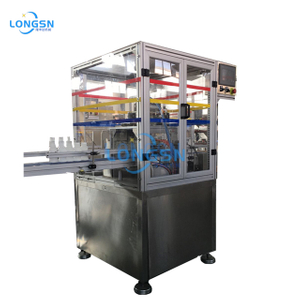In the modern beverage and packaging industries, efficiency is the cornerstone of profitability and competitiveness. One of the critical stages in bottling operations is the preparation of the bottles themselves, including shaping, trimming, and finishing. Among the machines that have revolutionized this process, the bottle neck cutting machine stands out as a vital tool. By automating and streamlining the cutting of bottle necks, these machines significantly improve the efficiency, accuracy, and safety of bottling operations.
Bottle neck cutting machines are designed to process bottles quickly and uniformly, ensuring that each bottle meets quality standards while reducing production downtime. This technology has become essential in industries ranging from soft drinks and bottled water to pharmaceuticals and cosmetics. Understanding how these machines contribute to efficiency can help businesses optimize their production lines, reduce waste, and maintain high-quality output.
Understanding the Bottle Neck Cutting Process
A bottle neck cutting machine is specifically engineered to trim or modify the neck of a bottle to meet precise specifications. The neck of a bottle is crucial for capping, sealing, and compatibility with closures or dispensing equipment. Improperly finished bottle necks can lead to leaks, misaligned caps, and production delays.
The machine works by using precision blades or cutting tools to remove excess material from the bottle neck. Depending on the design, it can handle different types of bottles, including glass, PET, or other plastics, and can accommodate various sizes and shapes. Modern machines can be fully automated, incorporating sensors, conveyors, and alignment systems to ensure consistent quality.
By automating this process, manufacturers eliminate the variability and errors associated with manual cutting. Bottles emerge ready for filling, capping, and labeling, significantly reducing bottlenecks in production.
Enhancing Production Speed
One of the most direct ways a bottle neck cutting machine improves efficiency is by increasing production speed. Manual cutting of bottle necks is labor-intensive, time-consuming, and prone to inconsistency. Even a skilled worker cannot match the speed and precision of an automated machine.
Automated machines can process hundreds or even thousands of bottles per hour, depending on the model and configuration. Continuous operation ensures that large production batches are completed on schedule, reducing downtime and allowing businesses to meet high-demand periods without sacrificing quality.
Moreover, modern machines often feature adjustable speeds and cutting settings, allowing manufacturers to optimize production based on bottle material, thickness, and size. This flexibility ensures that the machine can handle a wide range of products efficiently, further increasing throughput and reducing production delays.
Improving Product Quality and Consistency
Quality control is a critical concern in any bottling operation. Bottles with uneven or improperly cut necks can lead to sealing problems, leaks, or customer complaints. A bottle neck cutting machine ensures that every bottle is cut with precision, maintaining consistent dimensions and smooth edges.
By achieving uniformity, manufacturers reduce the risk of defective products entering the production line. This consistency also supports downstream operations, such as automated capping and labeling, which rely on precise bottle dimensions for proper alignment.
Consistent neck cutting enhances the overall aesthetic of the final product as well. Bottles that are uniform in appearance convey professionalism and quality, improving brand perception and customer satisfaction.
Reducing Material Waste
Inefficient bottle cutting processes can result in significant material waste. Manual trimming or poorly calibrated equipment often leads to uneven cuts, broken bottles, or excess material that must be discarded.
A bottle neck cutting machine minimizes waste by using precise, computer-controlled cutting mechanisms. These machines remove only the necessary material from each bottle, ensuring optimal use of raw materials. Over time, this reduction in waste translates into lower production costs and a more sustainable operation.
In addition, consistent cutting reduces the likelihood of damage during filling and capping, further preventing losses. By minimizing material waste, businesses not only save money but also demonstrate environmental responsibility, which is increasingly valued by consumers and regulatory bodies alike.
Enhancing Workplace Safety
Safety is a paramount concern in any manufacturing environment. Manual bottle cutting exposes workers to sharp edges, repetitive strain, and the risk of accidents. Using a bottle neck cutting machine significantly reduces the risk of workplace injuries by automating the process and incorporating safety features such as guards, sensors, and emergency stop functions.
Automated machines limit direct human contact with cutting blades, ensuring that workers can operate the equipment from a safe distance. This not only protects employees but also reduces downtime caused by accidents, further contributing to production efficiency.
Moreover, well-designed machines include features like automatic feeding and alignment, which prevent jams and ensure smooth operation. By combining automation with safety measures, manufacturers create a more secure and productive working environment.
Supporting High-Volume Operations
For companies handling large-scale bottling operations, throughput and reliability are critical. A bottle neck cutting machine enables high-volume production without compromising quality. Multiple machines can be integrated into production lines, creating continuous workflows where bottles are trimmed, aligned, filled, capped, and labeled in a seamless process.
High-volume capability also allows businesses to respond effectively to market demand. During peak seasons or promotional periods, automated neck cutting ensures that production targets are met without requiring additional labor or manual intervention. This scalability is essential for companies looking to expand their operations or serve multiple markets efficiently.
Flexibility and Adaptability
Modern bottle neck cutting machines offer significant flexibility and adaptability. Many machines can handle bottles of different sizes, shapes, and materials, making them suitable for a wide range of products. Adjustable cutting heads, programmable settings, and quick-change tooling allow manufacturers to switch between products with minimal downtime.
This adaptability supports product diversification, enabling companies to offer multiple bottle designs or seasonal variations without investing in multiple machines. By reducing setup times and simplifying production changes, manufacturers can maintain high efficiency even when managing a diverse product portfolio.
Integration with Automation Systems
A major advantage of bottle neck cutting machines is their ability to integrate with automated production lines. These machines can be synchronized with conveyors, filling stations, and labeling systems, creating a fully automated bottling process.
Integration reduces manual handling, minimizes human error, and ensures that production flows smoothly from start to finish. Real-time monitoring and feedback systems can detect issues such as misaligned bottles or blade wear, allowing for immediate adjustments without halting the entire line.
This level of automation enhances overall operational efficiency, reduces labor costs, and ensures consistent product quality across large batches.
Maintenance and Longevity
Regular maintenance of a bottle neck cutting machine is essential for maximizing efficiency. Modern machines are designed for durability and ease of service, with replaceable blades, modular components, and automated lubrication systems.
Routine maintenance prevents unexpected breakdowns, maintains cutting precision, and extends the machine’s lifespan. By investing in high-quality machines and proper upkeep, manufacturers can achieve long-term efficiency gains and reliable production performance.
Cost-Benefit Considerations
While the initial investment in a bottle neck cutting machine may be higher than manual labor or basic cutting tools, the long-term benefits far outweigh the costs. Increased production speed, reduced material waste, improved safety, and consistent quality all contribute to a favorable return on investment.
Companies can achieve faster throughput, lower labor costs, and fewer defective products, ultimately improving profitability. In addition, modern machines often require less supervision, allowing staff to focus on other critical tasks, further enhancing operational efficiency.
Conclusion
A bottle neck cutting machine is an indispensable tool for modern bottling operations. By automating the precise trimming of bottle necks, these machines enhance production speed, ensure consistent quality, reduce material waste, and improve workplace safety. They support high-volume operations, offer flexibility for diverse products, and integrate seamlessly into automated production lines.
For beverage, pharmaceutical, and cosmetic manufacturers seeking to maximize bottling efficiency, investing in a high-quality bottle neck cutting machine is a strategic decision. The combination of precision, speed, safety, and adaptability ensures that production processes are streamlined, costs are minimized, and product quality is consistently maintained.
By incorporating this technology into bottling operations, businesses can stay competitive, meet market demands, and deliver high-quality products efficiently, making a bottle neck cutting machine a cornerstone of modern manufacturing excellence.

 English
English









